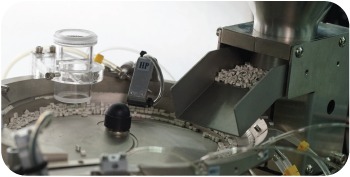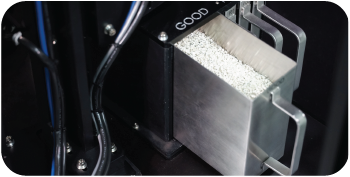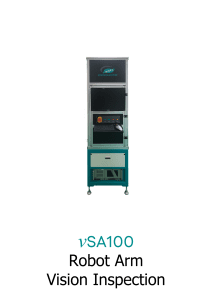Glass turret table

6S vision inspection module

The VI500 is a high-speed, 6S vision inspection system for small parts, made of plastic or metal. Coming from a vibrator bowl input, parts are presented to the vision system on a specially treated glass carrier and sorted into bins. It features realtime display of image acquisition & defects inspected.
Depending on the size and geometry of the parts, the machine inspects the product on the fly making the maximum speed up to 70,000 UPH. The VI500 is designed for fast conversion and is delivered including the complete vision system.
Features
- 6-Side Vision Inspection System:
- Comprehensive cosmetic inspection on all six sides—top, bottom, front, back, left, and right
- High Throughput:
- Capable of reaching up to 70,000 UPH depending on unit size and geometry
- Versatile Material Compatibility:
- Suitable for small parts made of various materials including plastic and metal
- Dual Image Capture:
- Equipped with different lighting setups to enhance defect detection across a wider range of surfaces and finishes
- Flexible Sorting Options:
- Multiple output bins configurable for various combinations such as Good, Reject, and Purge
- PC-Based Control System:
- Ensures flexible operation, data handling, and seamless integration
- Quick Product Conversion:
- Designed for fast and easy changeover across a wide range of product types
- Recycling of Rejected Units:
-
System reintroduces reject units back into the vibrator bowl for reprocessing, reducing waste and improving yield
-
Glass Turret AOI Machine/ VI500

Modules
- Input
Vibrator Bowl - Vision Station (5 setups)
- Output
Good / Reject / Purge Bins
Flowchart

Products from the vibrator bowl are delivered to the main turret in a consistent flow via a parts feeder.

The 6S Vision Inspection System performs a comprehensive cosmetic check on all six sides of the product — top, bottom, front, back, and both sides.

Multiple output bins are available for sorting inspected products into various categories such as Good, Reject, and Purge.
Connectors, Moulded parts, Small material, LED






6S Vision Inspection (Top, Bottom, Sides)
| Top Surface | Bottom Surface | Side Surface |
| Chipped Package | Lead Related Defects | Lead Related Defects |
| No Marking | Package Chipping | Package Chipping |
| Marking Alignment | Package Damage | Package Damage |
| Incomplete Mark | Resin Overflows | Contamination |
| Double Mark | Contamination | |
| Contamination | ||
| Bubble | ||
| No Resin | ||
| Excess Resin (Overfill) | ||
| Mix Device | ||
| Mixed Color | ||
| Limited Die | ||
| Wirebond Detection |
Machine Specification
| Products | Connectors, molding parts, small material, LED etc | |
| Specifications | Input: | Vibrator Bowl |
| Output: | Bins in various sizes and combinations | |
| UPH | Up to 40K, depending on product site/ geometry and inspection criteria | |
| Vision Inspection | 6S (Top, Bottom, Front, Back and Side) | |
| Footprint | 1650mm(W) x 1290(L) x 1950mm(H) | |
| Warranty | 1 year limited excluding wear and tear parts | |































